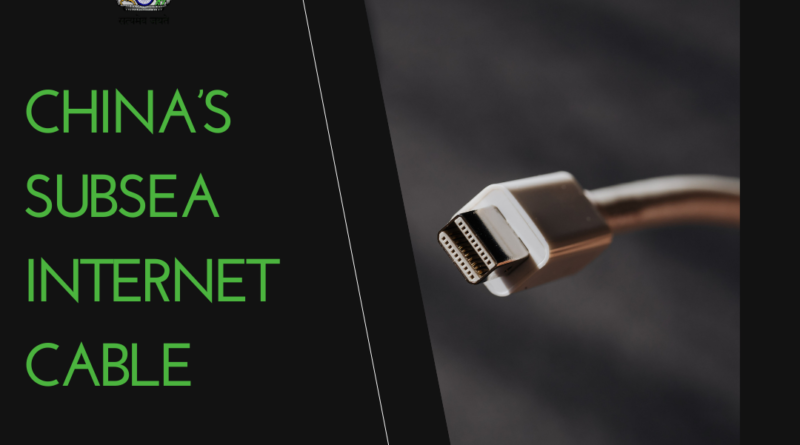China’s Subsea Internet Cable |IAS Banenge
Context
- To compete with a similar US-backed project, Chinese state-owned telecom companies are building a $500 million undersea fibre-optic internet cable network that would connect Asia, the Middle East, and Europe.
- The plan is a sign that an escalating tech conflict between Beijing and Washington runs the risk of rupturing the web’s infrastructure.
Relevance:
GS Paper-2: Bilateral, Regional and Global Groupings and Agreements involving India and/or affecting India’s interests; Effect of Policies and Politics of Developed and Developing Countries on India’s interests
Mains Question
“Chinese subsea internet cable networks are expanding, posing challenges to US diplomacy.” Examine the claim critically. (250 Words).
Read More –The Untold Story Unfolds: Chinese Scientists Reveal Long-Awaited Covid-19 Origins Data”- UPSC
Highlights:
- One of the most sophisticated and extensive subsea cable networks in the world is being planned by China’s three major carriers, China Telecommunications Corp. (China Telecom), China Mobile Limited, and China United Network Communications Group Co. Ltd. (China Unicom).
- The proposed cable, known as EMA (Europe-Middle-East-Asia), would connect Hong Kong to the Chinese province of Hainan before winding its way to France, Singapore, Pakistan, Saudi Arabia, and Egypt.The cable would be manufactured and laid by China’s HMN Technologies Co. Ltd, a rapidly expanding cable company whose predecessor company was majority-owned by Chinese telecom giant Huawei Technologies Co. Ltd. The cable’s estimated $500 million construction cost would be covered by this company.
The US-China Tech War
- The USA and China are at odds over eavesdropping on internet traffic, which has helped Beijing thwart a number of its international undersea cable projects over the past four years.
- In addition, Washington has prevented permits for projects led by Google LLC, Meta Platforms, Inc., and Amazon.com Inc. that would have connected the US with the Chinese territory of Hong Kong.
- Over 95% of all international internet traffic travels on submarine cables.
- But these cables, which are open to espionage and sabotage, have turned into weapons of influence in an escalating competition between the US and China. o These high-speed conduits have been owned for decades by groups of telecom and tech companies that pool their resources to build these vast networks so that data can move smoothly around the world.
- The superpowers are vying for control of cutting-edge technologies that will likely determine economic and military dominance in the coming decades.
- In addition, Washington has prevented permits for projects led by Google LLC, Meta Platforms, Inc., and Amazon.com Inc. that would have connected the US with the Chinese territory of Hong Kong.
- The Southeast Asia-Middle East-Western Europe-6 (SeameWe-6) cable, which is currently being built by the US company SubCom LLC and will also connect Singapore to France via Pakistan, Saudi Arabia, Egypt, and a half-dozen other nations along the route, is directly competing with the China-led EMA project.
- HMN Tech was initially chosen to build the SeaMeWe-6 cable by the consortium, which originally included China Mobile, China Telecom, China Unicom, and telecom carriers from several other countries. But last year, SubCom won the contract after a successful pressure campaign by the US government.
- As part of the US campaign, foreign telecom companies were offered millions of dollars in training grants in order to choose SubCom over HMN Tech. o The US Commerce Department also imposed sanctions on HMN Tech in December 2021 on the grounds that the company planned to purchase American technology to aid in the modernization of China’s People’s Liberation Army.
- This action made it impossible for owners of HMN-built cables to sell bandwidth to US tech firms, which are typically those companies’ biggest clients, undermining the project’s viability.
Beginning of EMA Project:
- After SubCom won the contract last year, China Telecom and China Mobile withdrew from the project. These companies, along with China Unicom, started planning the EMA cable.
- Although the three state-owned Chinese telecom companies are anticipated to hold a majority of the new network, they are also forming partnerships with foreign parties.
- The Chinese carriers signed separate memorandums of understanding with four telecoms, including Zain Saudi Arabia, a division of the Kuwaiti company Mobile Telecommunications Company K.S.C.P., Pakistan Telecommunication Company Ltd. (PTCL), and Telecom Egypt.
Way Ahead:
- The Chinese companies hope to finalise contracts by the end of the year and have the EMA cable online by the end of 2025. Large undersea cable projects typically take at least three years to complete from conception to delivery.
- The cable would benefit China strategically in its conflict with the US.
- First off, Washington would like to avoid the development of a brand-new, extremely fast connection between Hong Kong, China, and most of the rest of the world.
- Second, it expands the reach and protection of China’s state-backed telecom carriers in case they are ever cut off from US-backed cables.
- Countries should give security and privacy top priority in wireless networks, terrestrial and undersea cables, satellites, cloud services, and data centres in order to support an open and secure internet.





Pingback: Why Does India Extend Its Hand to Latin America? Ias Banenge - Ias Banenge